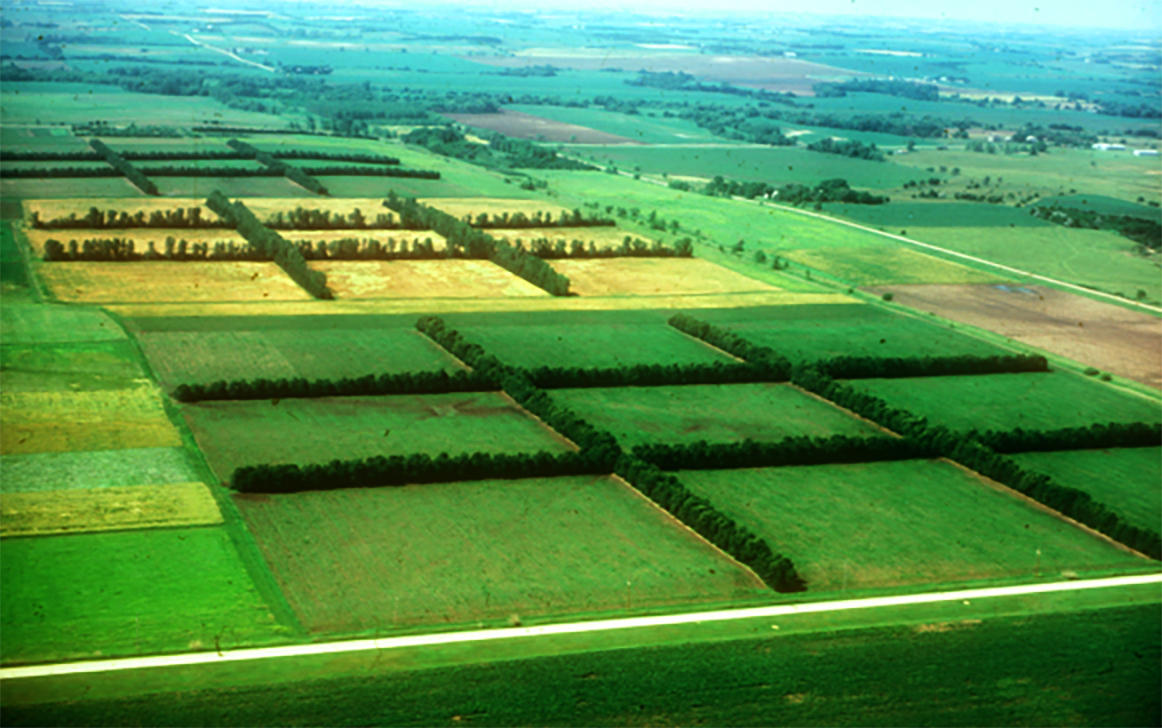
Celebrating 50 Years of
Shelterbelt Research
View Accomplishments Agroforestry Research Farm
Mission and History
The ARDC Agroforestry Farm is a working 500-acre farm with the only replicated, long-term shelterbelt study in the United States. The farm is part of the University of Nebraska - Lincoln's Agricultural Research and Development Center (ARDC) located 30 miles northeast of Lincoln. The 9,500 acre ARDC, site of the Mead Ordinance Plant, was acquired from the US Department of Defense in the early 1960's.
Professor Walt Bagley designed and started the shelterbelt study in 1966 in order to examine crop response to wind protection in the Great Plains, a topic of national interest since the 1930s Dust Bowl. The shelterbelt study consists of six 40-acre windbreak systems, each planted with a tic-tac-toe arrangement of windbreaks to create a set of small crop fields with differing degrees of wind protection. Some windbreaks have been added or removed since 1966, but the original design is largely intact and creates over 20 individual crop fields. Most of the fields have been in a corn-soybean-wheat rotation since the mid-1970's
Over the last 50 years, the ARDC Agroforestry Farm has also supported research including certified organic farm systems research, cover crop research, avian and pollinator habitat research, and selection studies for new Great Plains tree varieties. The ARDC Agroforestry Farm provides an excellent site for research, education, and outreach, and helps to address the role of agroforestry farm systems and their economic and environmental impacts.
Site Description
The ARDC Agroforestry Farm was set up in 1966 by Professor Walt Bagley, with six replications of double row windbreak systems. Each replication consisted of 16 ha (40 acres) divided into nine fields. The shelterbelts were composed of Eastern Red Cedar, Green Ash, Austrian Pine, Cottonwood, and Scotch Pine. Originally, only winter wheat was grown in the fields, but soybean, corn, sorghum (milo), and alfalfa have been added to the cropping studies.
Over the last 50 years, the shelterbelt replications have been altered from their original composition and structure. In the late 1970’s and early 1980’s, the dead and dying cottonwood trees were removed from the shelterbelts. The shelterbelts today consist mainly of Green Ash, Eastern Red Cedar, and Austrian Pine. Additionally, the structure of the shelterbelts have changed. Two of the replications were altered to become parallel windbreaks, and portions of the other four replications were altered to accommodate tree removal and changes in cropping studies. The current cropping system is a wheat-soybean-corn rotation.

Location
The ARDC Agroforestry Farm is located 3 miles east of Ithaca, NE (41° 09’ 10.8” N, 96° 29’ 34.5” W). It is approximately 38 minutes northeast from Lincoln, NE (30 miles) and 43 minutes southwest (35 miles) from Omaha, NE.
See DirectionsContacts

Dr. Jim Brandle
Emeritus Director
phone icon 402-472-6626
mail icon jbrandle1@unl.edu

Dr. Dave Wedin
Interim Director
phone icon 402-472-9608
mail icon dwedin1@unl.edu

Bruce Bolander
Unit Manager
phone icon 402-472-8080
mail icon bbolander1@unl.edu